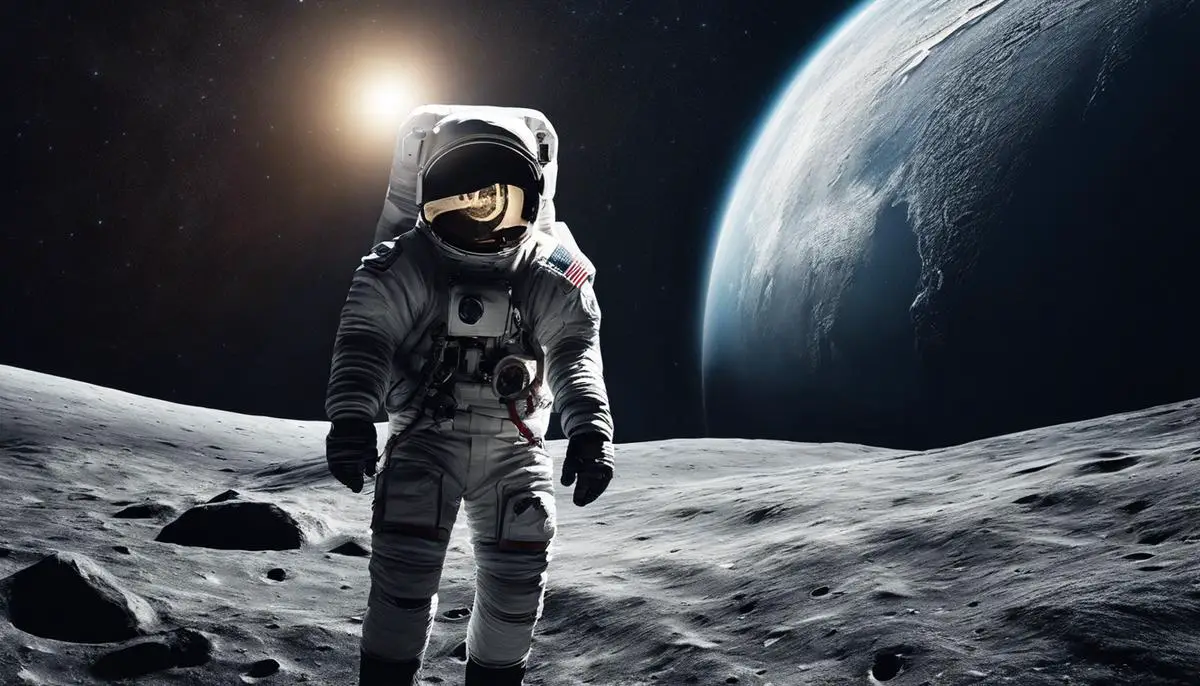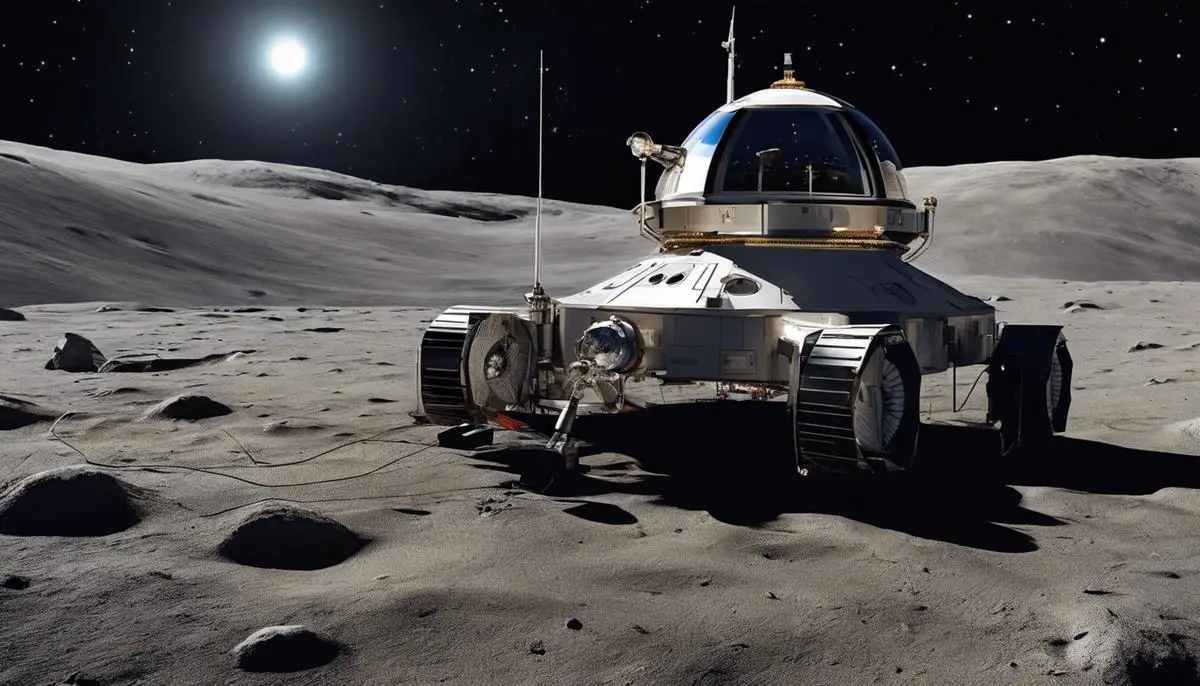The exploration of space and celestial bodies beyond Earth’s atmosphere signifies one of mankind’s most ambitious ventures. Among these bold adventures, the Apollo lunar expeditions stand uniquely significant for their blend of daring audacity and brilliant technical execution. This undertaking, that reached its zenith in the monumental achievement of placing a man on Moon, is not merely a story of technological developments. It also embodies astounding scientific breakthroughs and has left an indelible imprint on our collective consciousness, shaping our future dreams and endeavors in space exploration. Herein, we delve into the intricate technical feats that defined these expeditions, the consequential scientific discoveries they unfolded, and the gaming-changing legacies and inspirations they’ve instilled within us.
Contents
The Technical Feats of the Apollo Lunar Expeditions
Decoding the Success of the Apollo Lunar Expeditions: The Technical Advancements of a Historical Journey
In the annals of human achievement, few endeavors have as lasting a legacy as the Apollo lunar missions. Orchestrated by NASA between 1969 and 1972, these groundbreaking expeditions led to the first human footprints on the moon. But behind this monumental feat lay a myriad of technical advancements that made the seemingly impossible, possible. This treatise aims to elucidate these complexities and their dynamic interplay, which resulted in one of humankind’s most significant achievements.
Initially, the very backbone of the Apollo missions rested upon the unprecedented advancements in propulsion technology, epitomized by the renowned Saturn V rocket. Its ability to generate 7.6 million pounds of thrust was unprecedented, transcending existing barriers to space travel. Engineered by renowned scientists like Wernher von Braun, the Saturn V’s F-1 engine dwarfed contemporary equivalents, amply demonstrating mankind’s mastery over combustion and mechanical engineering.
In addition, the Lunar Module’s development, commonly known as the ‘Eagle’, was a fundamental aspect of the Apollo voyages. Possessing both descent and ascent stages, this purpose-built vehicle underwent countless modifications and iterations. It was this continuous pursuit of innovative design solutions that made lunar expeditions feasible, and cemented Apollo’s indelible mark on aerospace technology.
Equally instrumental were the advancements in computing and software development. The Apollo Guidance Computer (AGC), for example, served as the missions’ proverbial brain, capable of processing real-time data in an era when computers were predominantly colossal, both in size and power requirements. The development of the AGC, with its lightweight, compact design and robust reliability, quite literally took computing capabilities to new heights.
Beyond mechanical and electronic advancements, the development and application of newly conceived materials was critical. The invention of multi-layered insulation blankets, for instance, provided efficient thermal control for the spacecraft. Similarly, the delicate workings of the A7L spacesuit, developed by Playtex, equipped astronauts with the means to operate effectively under the harsh lunar environment’s strain.
Finally, another key component underpinning the missions’ success was the seismic leap in human factor engineering and mission logistics. Intensive astronaut training, detailed mission planning, and the commitment to monitoring every second from mission control were the cumulative reflection of meticulous study and planning. Such steadfast dedication exemplified how technical advancements were paralleled by equally significant improvements in the human aspects of spaceflight.
In conclusion, the success of the Apollo lunar expeditions was the result more than just a single ‘giant leap’ for mankind, but a symphony of technical advancements fine-tuned and harmonized over long, arduous years. Each technological milestone – from propulsion to computing, materials science to human factors – deserves thorough analysis for their roles in human space exploration’s evolution. As ever, from the rich tapestry of scientific achievement, the Apollo missions continue to inspire succeeding generations to dream, innovate, and break through the vise of terrestrial limitations.

Scientific Discoveries from the Apollo Expeditions
Unveiling Lunar Secrets: Significant Scientific Discoveries from the Apollo Lunar Expeditions
When pondering over the legacy of the Apollo lunar expeditions, the focus often veers towards the magnificent technological marvels that were conceived and perfected for these missions. However, beyond the realm of technological evolution and human factors, the Apollo lunar expeditions presented new frontiers in unraveling the mysteries of our celestial neighbor, the Moon, that have significantly enhanced our understanding of its history, geology, and inner mechanisms.
In the course of examining lunar rocks, the concept of lunar cataclysm, or “late heavy bombardment,” was born. The prevalence of impact basins and their dating to approximately 3.9 billion years ago strongly indicates a period of increased asteroidal and cometary impact flux. This discovery resonates beyond the lunar context, providing insights into the early solar system and the history of other celestial bodies.
Subsequently, analyses of these same samples enabled the estimations of the Moon’s age. Using radiometric dating methods, the Moon was found to be approximately 4.5 billion years old, closely mirroring the age of the Earth and other bodies within our solar system, reinforcing theories of the Moon’s formation from Earth’s debris, following a collision with a Mars-sized body named Theia.
The Apollo missions also unveiled the distinctive difference in lunar highland and mare basalts, rewarding scientists with insights into the Moon’s volcanic activity and internal dynamics. With varying compositions in terms of age and chemical elements, these distinct geological formations evince the extensive lunar volcanism, which, intriguingly, ceased about a billion years ago.
The discovery of the lunar surface’s patchy magnetic field was another unexpected revelation. Unlike Earth’s global magnetic field, the Moon’s magnetism is irregular and predominantly weak, except at certain anomalous points. This anomaly has instigated new theoretical developments about the dynamo effect, magnetic fields, and the cooling and alterations in rotating astronomical bodies.
Exploration of the lunar environment also revealed a surprising natural phenomenon, lunar mascons – large positive gravitational anomalies associated with certain impact basins. Their presence has implications on understanding the Moon’s internal structure and evolution, and also poses fascinating navigational challenges for spacecrafts.
Lastly, the measurements and observations of lunar recession and tidal dissipation, a consequence of gravitational interaction between Earth and the Moon, hold profound significance. Conducing to the development of a dynamic model of Earth-Moon evolution, these underpinnings could presage crucial elements of future space explorations.
In a nutshell, while the Apollo lunar expeditions spotlighted numerous technological and human factor breakthroughs, the comprehensive scientific discoveries unveiled have inevitably increased our understanding of the Moon, revolutionized lunar science, and proffered keys to the secrets locked in the time-capsule of the lunar surface.

Legacy and Future Inspiration of the Apollo Lunar Expeditions
The Apollo lunar expeditions left an indelible footprint not only on the dusty surface of our moon, but also on the scientific understanding of lunar geology, physics, and evolution. The groundbreaking discoveries made on these missions triggered a seismic shift in our knowledge of Earth’s only natural satellite, opening up unprecedented avenues for space exploration. The paucity of indigenous lunar atmosphere led to crucial examinations of impact craters and basins that provided valuable insights into the moon’s violent and turbulent past.
The Lunar cataclysms, a meteor bombardment period which occurred approximately 3.8 to 4 billion years ago, were responsible for a significant proportion of lunar impact basins. The study of these basins during the Apollo missions dramatically enhanced our understanding of this tumultuous period in the moon’s history. The identification and analysis of these topographical features prompted radical conjectures pertaining to the evolution of the lunar surface.
In that vein, the Apollo missions crystallized our understanding of the moon’s age. Prior to Apollo, estimates of the moon’s age varied widely. However, the lunar samples returned by the Apollo astronauts, particularly those replete with long-lived radioactive isotopes, enabled scientists to peg the Moon’s age at approximately 4.5 billion years – an understanding that aligns intriguingly with theories around Earth’s own formation.
The lunar surface is characterized by the stark dichotomy of the rugged, mountainous lunar highlands and the flat mare basalts. Precise analysis of these formations on the Apollo missions showed the highlands to be much older and significantly composed of a type of rock, anorthosite, supportive of the feldspar-rich crust of the early Moon. The mare basalts, meanwhile, are less cratered and relatively younger. These distinctive lunar regions have offered scientists profound clues regarding the Moon’s geologic history and development.
One surprise awaited the Apollo astronauts – patchy areas with higher than expected magnetism, now known as the Moon’s magnetic field. This was a telltale hint that the Moon had once harbored a molten, dynamic core that cooled over time. This magnetic field remains a fascinating conundrum for lunar scientists even today – explaining its distribution and strength is a cutting-edge area of lunar research.
The Apollo missions also shed light on the mysterious lunar mascons – regions of the lunar surface associated with a significantly higher gravitational pull. These mascons, thought to be remnants of ancient asteroid impacts, were discovered when navigational anomalies were observed in the Apollo spacecraft. Their discovery reshaped the understanding of the Moon’s gravity, with implications for future lunar-orbit planning and navigation.
Lastly, the concept of lunar recession and tidal dissipation were brought into sharper focus. Theories around the Moon gradually moving away from Earth, as deciphered from laser range-finding experiments from the Apollo missions, bolstered the assertions around the time-tidal friction associated with moon’s influence.
In closing, the enduring legacy of the Apollo lunar expeditions and their far-reaching influences have been monumental in their proliferation of knowledge, probing into the heart of our celestial neighbor. They have provided a stepping stone for future space exploration, each revelation propelling us toward a deeper grasp of not only our Moon but also of planetary science in general. The revolution ignited by these missions continue to influence and steer exploration efforts through the vast, ever-mysterious expanse that is space.

The Apollo lunar expeditions are not mere historical events held captive in the annals of the past. Their impact reverberates today, in how we perceive space exploration and in the dreams we hold for the future. The technical marvels of these missions have laid the foundation for several contemporary and impending space programs. Scientific discourses emanated from these expeditions continue to shape lunar research, guiding our understanding and strategies for exploiting lunar resources. Furthermore, the inspirational legacy they bequeathed has emerged as a powerful motivator, fuelling generations to push the boundaries of what’s possible. Hence, as we continue to traverse the vast cosmos, we carry the echoes of the Apollo expeditions, serving as resounding reminders of our capabilities and illuminating beacons guiding our journey into the unknown reaches of space.
